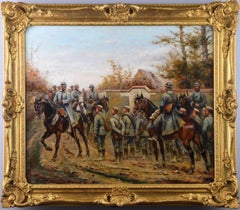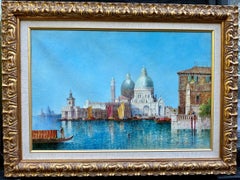Antique oil 19th century View of Venice, Santa Maria Della Salute from a canal.
View of the Santa Maria Della Salute in Venice by one of England's best-known landscape and Venetian painters.
This example is a very well-painted piece and is a great composition.
It is framed in an English Classic running pattern
Tracing the story of William Meadows, the son of James Meadows, is sometimes a little difficult. In earlier census returns he gave his place of birth as Epping, but in later census returns he said that he was born in Mountnessing in about 1825. Between 1841 and 1901 William is recorded as William James, William George, and in 1881 simply as George, and these apparent changes of name were explained by a chaotic personal life which contrasts with his tranquil paintings of the English countryside and Venice.
An entry in The Fine Arts Journal in 1847, concerning the Theatre Royal, Dumfries, reveals that "The scene-painter is Mr. W.J.Meadows, the son of Mr. Meadows, of the Surrey”. Initially, William had begun his career by following in the family footsteps at one of the theatres where his grandfather had performed. However, his training as a scene painter most probably came closer to home under his father's tuition, possibly at The Lyceum Theatre in London in 1844. (See the previous page on James Meadows for further details).
In 1850, William married Lydia Maria Jarvis (born in Norwich c.1826) at St Pancras Old Church, close to St Pancras Station in London. By the time that the census was taken the following year, William and Lydia were living at 16, High Street in Poole, Dorset. So far it has been not been possible to identify a census entry for 1861 for the couple. However, when William exhibited "A scene in Surrey' at the Royal Hibernian Academy of Arts in Dublin in 1865, he gave his address as 187, Hampstead Road, London, not far from the St Pancras area once again.
The reason for William's obscurity in the 1861 census may lie partially in his financial difficulties, as well as his frequent changes of address. In 1864, The Law Journal's list of impending bankruptcy proceedings included an entry for "Meadows, William George (known as William James Meadows), artist, of Old Kent Road, previously of Beal Road, Old Ford, previously of Wanstead Flats, Wanstead". A family source has revealed that William tried changing career not long afterward, when he became the landlord of The Black Bull Inn in Fyfield in Essex on the 9th November 1866, and that he "gave an opening dinner there" on 29th November 1866. However, if William was trying to achieve financial stability by changing careers, the 1871 census would suggest that it was an unsuccessful interlude.
In 1871 William was recorded under the name of William George but is identifiable as the same person by his age, place of birth, and the personal details of his wife. He no longer gave his profession as an artist, but as an "Eating Housekeeper", back in the East End of London and living at 200, High Street in Shoreditch. Two servants were living with the couple, but more unusually there was also another resident, whose occupation was listed as "bailiff in possession". The presence of a live-in bailiff, therefore, seems to suggest that William's financial difficulties were far from over.
In addition to his financial woes, William’s marriage to Lydia also appears to have been a stormy affair. In 1867 in London she petitioned for a divorce from William, although she must have been initially reconciled to him as the couple was living together (with their bailiff!) in 1871. However in 1874, Lydia once again petitioned for a divorce and this time the separation was definitive, and Lydia moved to a separate address in Holborn where she was living at the time of the 1881 census as a "retired publican". William, meanwhile, married for a second time in Southwark in 1875, under the name of William George Meadows.
His second wife, Helen Grace Higgs, was born in Tipperary in Ireland in about 1841. By the time of the 1881 census, the couple was lodging over a pub at 87, High Holborn in London, where William is recorded simply as "George Meadows, Landscape painter". In the 1891 census, the couple was lodging at
The Green Dragon...


